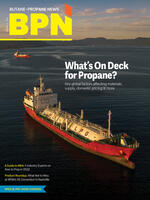
You may have seen the AT&T commercial advertising a new smartphone that everyone can get for the same price. To prove this point, the AT&T employee hands a little girl a small lollipop and hands her brother a large one. The little girl complains to the AT&T employee, “It isn’t fair!” At this point, she is given the larger lollipop, which is the same size as her brother’s, to prove the point that everyone can get the same deal.
At some point in life, you and I have come to the same conclusion that “it isn’t fair,” but that doesn’t mean that someone or something can make everything fair. I had this realization when I was only 5 years old. I was with friends, and we were walking down to a gas station that sold candy. For only a nickel, one could buy several different kinds of candy. All of the other boys had a nickel, but I didn’t. We walked outside, and while they ate their candy, I could only look on and dream of the day that I could buy some, too.
As I got older, the “it isn’t fair” differences became more pronounced. I wasn’t as tall as some of the guys playing basketball. Some parents had more money. I also learned that “it isn’t fair” when it comes to the quality of goods. Items come in “good, better or best,” which applies to most things we buy. More and more, I came to realize that if I wanted the better things in life, I was going to have to work for them. Sometimes that meant working two or three jobs at the same time.
Every day, I speak with hardworking, conscientious propane marketers who were taught that if they worked hard and developed a culture of safety, they could get a better deal when buying property and casualty insurance than the marketer who wasn’t operating safely. Marketers will complain that it isn’t fair when premiums rise every year, especially if they had no claims within the last several years. And the innuendo is that the agent or the insurance company is getting rich off their company. So, let’s look at the lollipop that insurance companies are giving marketers on their 2022 renewal plans and then look at factors influencing their pricing.
First of all, take the example of property insurance. The 2021 year had 1,278 tornadoes recorded in the United States. In addition, there were 21 named hurricanes, with seven that did a lot of damage. The insured property losses were in the billions of dollars. To finish the 2021 year, the Marshall Fire burned almost 1,000 homes in Boulder County, Colorado, adding another billion dollars in losses. These natural disasters are all contributing to the increase in property losses, which in turn are forcing property insurance rates to increase.
An article published by the Insurance Journal on Jan. 25, 2022, pointed out that the property and casualty industry raised rates by an average of 10% during the first nine months of 2021 and that “loss costs outpaced the increase in premiums.” In addition, marketers are facing inflation the likes of which we have never seen. The cost of steel, I am told, has risen more than 82%. Lumber pricing now costs more than $1,000 per 1,000 board foot, and a dwindling workforce has sharply raised the cost of construction and the time it takes to construct.
The construction delays caused by supply chain problems mean that it is taking longer to reconstruct and replace damaged buildings and to replace contents, which further adds to replacement costs. This is why it is strongly recommended that marketers carry business income and extra expense on their property policies. The other factor to carefully consider when marketers are renewing their property insurance is to make sure that buildings, tanks and contents meet the co-insurance requirements shown in your insurance policy.
In terms of auto insurance, the signs point to auto insurance premiums continuing to increase for several reasons. Numerous lawyers are advertising and involved in seeking maximum bodily injury limits in accidents. Auto premiums are forced to increase because the general public and juries mistrust business and insurance companies; the result is “nuclear verdicts.” The cost to repair vehicles is up due to parts shortages and lack of skilled auto body and mechanical technicians, which are in short supply.
The critical miscellaneous coverages, such as employment practices liability and cyber liability, are also facing huge losses, which are requiring upward premium adjustments as well as forcing some insurance companies to withdraw from some states. The COVID-19 pandemic over the last two years has caused employee claims to skyrocket. Controversial rules and regulations for employers and government handouts paying more than employees could make have added to the divide between employer and employees.
The situation for cyber liability is much the same. Hackers — many of whom are from outside of the U.S. — have breached many government and business entities. Millions of dollars have been paid out from cyber extortion. Some claims have been covered by insurance, while the majority have been covered by the private sector.
The problem is that there doesn’t seem to be a solution to stop the security breaches — as soon as one solution is put forward, the hackers are able to find another way into the computer systems. The insurance companies that are writing cyber insurance are also being forced to raise rates or stop writing this line of coverage. Again, this is a coverage that every marketer should purchase.
Finally, let’s talk about the umbrella coverage marketplace. Propane marketers need coverage for pollution claims even though propane becomes a vapor and disburses when released. The MCS-90 endorsement is also required when purchasing umbrella coverage, which limits the number of insurance companies willing to write umbrellas.
For many years, umbrellas have been written through Lloyd’s of London. However, with the British leaving the European Union, Lloyd’s has been forced to take a second look at their book of business and its profitability, which has shown a loss for the past six years. “Nuclear judgments” from transportation claims, as well as the fact that insurance is now worldwide, means that umbrella rates are also increasing and markets are tightening.
Marketers in 2022 should expect an increase in premiums and a tightening marketplace with fewer companies writing for propane and refined fuels. However, they are still all getting the same deal: they have insurance.



